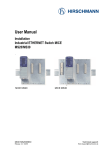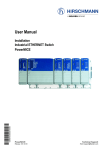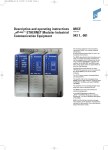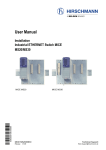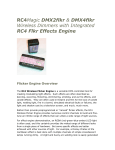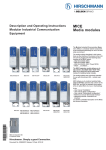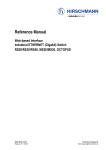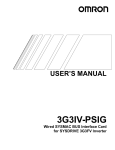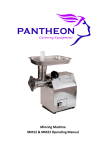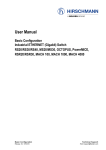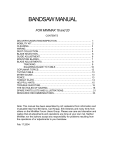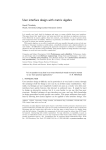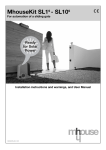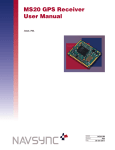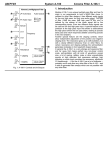Download Installation: Industrial ETHERNET Switch MICE MS20 - e
Transcript
User Manual Installation Industrial ETHERNET Switch MICE MS20/MS30 MICE MS20 Installation MS20/MS30 Release 11 07/2013 MICE MS30 Technische Unterstützung https://hirschmann-support.belden.eu.com The naming of copyrighted trademarks in this manual, even when not specially indicated, should not be taken to mean that these names may be considered as free in the sense of the trademark and tradename protection law and hence that they may be freely used by anyone. © 2013 Hirschmann Automation and Control GmbH Manuals and software are protected by copyright. All rights reserved. The copying, reproduction, translation, conversion into any electronic medium or machine scannable form is not permitted, either in whole or in part. An exception is the preparation of a backup copy of the software for your own use. For devices with embedded software, the end-user license agreement on the enclosed CD/DVD applies. The performance features described here are binding only if they have been expressly agreed when the contract was made. This document was produced by Hirschmann Automation and Control GmbH according to the best of the company's knowledge. Hirschmann reserves the right to change the contents of this document without prior notice. Hirschmann can give no guarantee in respect of the correctness or accuracy of the information in this document. Hirschmann can accept no responsibility for damages, resulting from the use of the network components or the associated operating software. In addition, we refer to the conditions of use specified in the license contract. You can get the latest version of this manual on the Internet at the Hirschmann product site (www.hirschmann.com). Printed in Germany Hirschmann Automation and Control GmbH Stuttgarter Str. 45-51 72654 Neckartenzlingen Deutschland Tel.: +49 1805 141538 Installation MS20/MS30 039 530-001-11-0713 – 25.7.13 Contents Safety instructions 5 About this Manual 14 Legend 14 1 Description 15 1.1 General device description 15 1.2 Device name and product code 16 1.3 Description of the device variants 1.3.1 Number of ports and connections 1.3.2 Media modules 1.3.3 Digital I/O Module MM24 1.3.4 MB20 extender module 1.3.5 SFP Transceiver 17 18 21 25 26 26 1.4 Display elements 1.4.1 Device status 1.4.2 Display status 1.4.3 Port status 26 28 29 29 2 Assembly and start-up 31 2.1 Unpacking and checking 31 2.2 Installing the media modules 32 2.3 Filling out and attaching labels 32 2.4 Installing the SFP transceivers (optional) 33 2.5 Adjusting the DIP switch settings on the basic module (4-pin DIP switch) 34 Adjusting the DIP switch settings on the MS20/MS30-...E... basic module (3-pin DIP switch) 35 Adjusting the DIP switch settings on the MM20-A8A89999SAHH media module 37 2.8 Connecting the MM22-T1T1T1T1 PoE media module 37 2.9 Terminal block for supply voltage and signal contact 2.9.1 Supply voltage 2.9.2 Signal contacts 39 39 39 2.6 2.7 Installation MS20/MS30 Release 11 07/2013 3 2.10 Connecting the terminal blocks, start-up procedure 2.10.1 Terminal blocks on MS20/MS30-...A... and MS20/MS30-...C... 2.10.2 Terminal block on MS20/MS30-...E... 2.10.3 Startup procedure 40 41 41 2.11 Installing the device on the DIN rail, grounding 2.11.1 Mounting on the DIN rail 2.11.2 Grounding 42 42 42 2.12 Connecting the data lines 2.12.1 10/100 Mbit/s twisted pair port 2.12.2 10/100 Mbit/s PoE/PSE port 2.12.3 10/100/1000 Mbit/s twisted pair port 2.12.4 100 Mbit/s F/O port 2.12.5 1000 Mbit/s F/O port 2.12.6 AUI port 43 43 43 44 45 45 45 2.13 Assembly of the MB20 extender module 47 2.14 Defining the meaning of the display LEDs 47 3 Basic set-up 48 4 Maintenance and service 50 5 Deinstallation 51 6 Technical data 52 A Further Support 75 Installation MS20/MS30 Release 11 07/2013 40 4 Safety instructions Certified usage Only use the device for application cases that are described in the Hirschmann product information, including this manual. Only operate the device according to the technical specifications. Supply voltage For safety reasons the devices have been designed to operate at low voltages. Thus, they may only be connected to the supply voltage connections and to the signal contact with SELV circuits with the voltage restrictions in accordance with IEC/EN 60950-1. The supply voltage is electrically isolated from the housing. Use undamaged parts. Relevant for North America: The device may only be connected to a Class 2 supply voltage that fulfills the requirements of the National Electrical Code, Table 11(b). If the voltage is being supplied redundantly (two different voltage sources), the combined supply voltages must fulfill the requirements of the National Electrical Code, Table 11(b). Relevant for North America: For use in Class 2 circuits. Only use copper wire/conductors of class 1, 75 °C (167 °F). Relevant for North America for modules certified for Hazardous Locations: This equipment is suitable for use in Class 1, Division 2, Groups A, B, C and D or Non-Hazardous (unclassified) locations only. Make sure that peripheral devices are suitable for the application environment. The wiring for the voltage supply and for the inputs and outputs (I/O) must adhere to the wiring regulations for Class 1, Division 2 [article 501(b) of the National Electrical Code (USA), NFPA 70] and to the applicable statutory regulations. Note: Observe the control drawing (document number 000160011DNR) on the following pages. Relevant for Europe for devices installed in explosive gas atmospheres according to ATEX directive 94/9 EC: Make sure that the device has the following label: II 3G (... followed by additional specifications). Note: Observe the control drawing (document number 000160011DNR) on the following pages. Installation MS20/MS30 Release 11 07/2013 5 2UGLQDU\/RFDWLRQ 1RQ+D]DUGRXV$UHD QRQH[SORVLYHDWPRVSKHUH WARNING! The USB connection and the V.24 Interface connection are for temporary connection only, for maintenance use. Do not use, connect or disconnect unless the area is known to be non-hazardous. Connection or disconnection in an explosive atmosphere could result in an explosion! Power Supply range “C” (P1, P2 Redundant) 18 – 60 VDC; 4.0 – 1.2 A; max. 72 W Relay contacts: Equipment with nonincendive field wiring parameters. Polarity is not relevant. THE RELAY TERMINALS ARE DEPENDENT UPON THE FOLLOWING ENTITY 1 2 PARAMETERS: ) ) Ui 30 V Ii 90 mA Ci 2 nF =RQH([SORVLYH$WPRVSKHUH RU&ODVV,'LYLVLRQ *URXSV$%&' +D]DUGRXV/RFDWLRQ MS20/30 switch basic module with voltage range type “C” P1 Relay P2 Relay Li 1 µH Temperature Code: T4 Ambient Temperature rating: Ta: 0 °C to +60 °C for “S” types Ta: -40 °C to +70 °C for “T” or “E” types ²UHIHUWRWKHW\SHGHVLJQDWLRQRQWKHGHYLFH 3RVLWLRQRIQRPHQFODWXUH´7HPSHUDWXUHUDQJHµ The earth conductor must be at least the same wire size (mm² or AWG) as the supply conductors. CONTROL DRAWING IRU,QGXVWULDO(7+(51(75DLO6ZLWFK06DQG06GHYLFHV 943-435-999 according to the directive 94/9/EC or Class I Division 2 Hazardous Locations Version: 2 Document No.: 000160011DNR 6 Page 1/4 Installation MS20/MS30 Release 11 07/2013 2UGLQDU\/RFDWLRQ 1RQ+D]DUGRXV$UHD QRQH[SORVLYHDWPRVSKHUH WARNING! The USB connection and the V.24 Interface connection are for temporary connection only, for maintenance use. Do not use, connect or disconnect unless the area is known to be non-hazardous. Connection or disconnection in an explosive atmosphere could result in an explosion! Relay contacts: Equipment with nonincendive field wiring parameters. Polarity is not relevant. THE RELAY TERMINALS ARE DEPENDENT UPON THE FOLLOWING ENTITY 1 2 PARAMETERS: ) ) Ui 30 V Ii 90 mA Ci 2 nF Li 1 µH =RQH([SORVLYH $WPRVSKHUH RU&ODVV,'LYLVLRQ *URXSV$%&' +D]DUGRXV/RFDWLRQ MS20/30 switch basic module with voltage range type “A” Relay Relay P1 Power Supply range “A” (P1, P2 Redundant) 18 – 32 VDC; 4.0 – 2.25 A; max. 72 W P2 Temperature Code: T4 Ambient Temperature rating: Ta: 0°C to +60°C for “S” types Ta: -40°C to +70°C for “T” or “E” types ²UHIHUWRWKHW\SHGHVLJQDWLRQRQWKHGHYLFH 3RVLWLRQRIQRPHQFODWXUH´7HPSHUDWXUHUDQJHµ The earth conductor must be at least the same wire size (mm² or AWG) as the supply conductors. CONTROL DRAWING IRU,QGXVWULDO(7+(51(75DLO6ZLWFK06DQG06GHYLFHV 943-435-999 according to the directive 94/9/EC or Class I Division 2 Hazardous Locations Version: 2 Document No.: 000160011DNR Installation MS20/MS30 Release 11 07/2013 Page 2/4 7 For Use in explosive atmospheres under the European directive 94/9/EC: Applied Standards: EN60079-0, 2009 EN60079-15, 2010 EN60079-11, 2012 7KH8VHLQ+D]DUGRXV/RFDWLRQVZLWKH[SORVLYHDWPRVSKHUHVLVRQO\DOORZHGIRU06RU06PRGHO 1RVZKLFKDUHLQGLYLGXDOO\ODEHOOHG ´,,*µDQG´([Q$LF,,&7*FµDQG´'(.5$$7(;;µIRU06[[GHYLFHV ´,,*µDQG´([Q$,,&7*FµDQG´'(.5$$7(;;µIRU0%GHYLFHV 6SHFLDOFRQGLWLRQVIRUVDIHXVH 7KHPRGXOHVVKDOOEHLQVWDOOHGLQDVXLWDEOHHQFORVXUHLQDFFRUGDQFHZLWK(1WDNLQJLQWR DFFRXQWWKHHQYLURQPHQWDOFRQGLWLRQVXQGHUZKLFKWKHHTXLSPHQWZLOOEHXVHG 3URYLVLRQVVKDOOEHPDGHWRSUHYHQWWKHUDWHGYROWDJHIURPEHLQJH[FHHGHGE\WUDQVLHQW GLVWXUEDQFHVRIPRUHWKDQ9 :KHQWKHWHPSHUDWXUHXQGHUUDWHGFRQGLWLRQVH[FHHGV&DWWKHFDEOHRUFRQGXLWHQWU\SRLQWRU &DWWKHEUDQFKLQJSRLQWRIWKHFRQGXFWRUVWKHWHPSHUDWXUHVSHFLILFDWLRQRIWKHVHOHFWHGFDEOH VKDOOEHLQFRPSOLDQFHZLWKWKHDFWXDOPHDVXUHGWHPSHUDWXUHYDOXHV 1 Note ): The nonincendive field wiring circuit concept allows interconnection of nonincendive field wiring apparatus and associated nonincendive field wiring apparatus using any of the wiring methods permitted for unclassified locations when certain parametric conditions are met. Capacity: C0 Ci + CCable ; Inductivity: L0 Li + LCable The maximum cable length has to be determined as follows: (a) max. Cable Length < (L0 - Li) / Cable L (“Cable L” denotes the inductance per unit length of used cable) and (b) max. Cable Length < (C0 - Ci) / Cable C (“Cable C” denotes the capacitance per unit length of used cable). The lower value of (a) and (b) is to apply. Manufactured in 72654 Neckartenzlingen / Germany by Hirschmann Automation and Control GmbH. DOM: ww/yyyy (Date of manufactur: w - week, y - year. Refer to the device label). CONTROL DRAWING IRU,QGXVWULDO(7+(51(75DLO6ZLWFK06DQG06GHYLFHV 943-435-999 according to the directive 94/9/EC or Class I Division 2 Hazardous Locations Rev.: 2 Document No.: 000160011DNR 8 Page 3/4 Installation MS20/MS30 Release 11 07/2013 For Use in Hazardous Locations Class I Division 2 Groups A, B, C, D: Applied standard: ANSI/ISA 12.12.01-2011. 2QO\DOORZHGIRU06RU06PRGHO1RVZKLFKDUHLQGLYLGXDOO\ODEHOOHG ´)2586(,1+$=$5'286/2&$7,216µ 1RQLQFHQGLYHILHOGZLULQJFLUFXLWVPXVWEHZLUHGLQDFFRUGDQFHZLWKWKH 1DWLRQDO(OHFWULFDO&RGH1(&1)3$DUWLFOH WARNING – EXPLOSION HAZARD – SUBSTITUTION OF ANY COMPONENTS MAY IMPAIR SUITABILITY FOR HAZARDOUS LOCATIONS OR EXPLOSIVE ATMOSPHERES. WARNING – EXPLOSION HAZARD – DO NOT DISCONNECT EQUIPMENT UNLESS POWER HAS BEEN SWITCHED OFF OR THE AREA IS KNOWN TO BE NONHAZARDOUS. Use 60/75 or 75 °C copper (CU) wire only. Only for connection to a Class 2 power supply. 2 Note ): The nonincendive field wiring circuit concept allows interconnection of nonincendive field wiring apparatus and associated nonincendive field wiring apparatus using any of the wiring methods permitted for unclassified locations when certain parametric conditions are met. Capacity: Ca Ci + CCable ; Inductivity: La Li + LCable The maximum cable length has to be determined as follows: (a) max. Cable Length < (La - Li) / Cable L (“Cable L” denotes the inductance per unit length of used cable) and (b) max. Cable Length < (Ca - Ci) / Cable C (“Cable C” denotes the capacitance per unit length of used cable). The lower value of (a) and (b) is to apply. Manufactured in 72654 Neckartenzlingen / Germany by Hirschmann Automation and Control GmbH. DOM: ww/yyyy (Date of manufactur: w - week, y - year. Refer to the device label). CONTROL DRAWING IRU,QGXVWULDO(7+(51(75DLO6ZLWFK06DQG06GHYLFHV 943-435-999 according to the directive 94/9/EC or Class I Division 2 Hazardous Locations Rev.: 2 Document No.: 000160011DNR Installation MS20/MS30 Release 11 07/2013 Page 4/4 9 Shielded ground The shielded ground wire of the twisted pairs lines is connected to the front panel as a conductor. Beware of possible short circuits when connecting a cable section with conductive shield braiding. Housing WARNING ELECTRIC SHOCK Never insert sharp objects (small screwdrivers, wires, etc.) into the inside of the device. Never insert sharp objects (small screwdrivers, wires, etc.) into the connection terminals for the supply voltage or the signal contact, and do not touch the terminals! Failure to follow these instructions can result in death, serious injury, or equipment damage. CAUTION OVERHEATING OF THE DEVICE When installing the device, ensure that the ventilation slots are not covered. Make sure there is at least 10 cm (3.94 in) of space. Failure to follow these instructions can result in injury or equipment damage. Only technicians authorized by the manufacturer are permitted to open the housing. The lower panel of the device is grounded by means of the DIN rail and optionally by means of the separate ground screw. The switch basic module is an inseparable unit. The switch basic module may be damaged by detachment of the display and connection part. Verify that the electrical installation meets locally or nationally applicable safety regulations. Keep the ventilation slits free to ensure good air circulation. Make sure there is at least 10 cm of space in front of the ventilation slits of the housing. The device has to be mounted in an upright position (see figure 18). If you are operating the device in a living area or office environment, only operate it in switch cabinets with fire protection characteristics in accordance with EN 60950-1. 10 Installation MS20/MS30 Release 11 07/2013 Environment Only operate the device at the specified ambient temperature (temperature of the ambient air at a distance of up to 5 cm from the device) and at the specified relative humidity. See “General technical data” on page 52. When you are selecting the installation location, make sure you observe the climatic threshold values specified in the technical data. Only to be used in an environment with the pollution degree specified in the technical data. Qualification requirements for personnel Qualified personnel as understood in this manual and the warning signs, are persons who are familiar with the setup, assembly, startup, and operation of this product and are appropriately qualified for their job. This includes, for example, those persons who have been: trained or directed or authorized to switch on and off, to ground and to label power circuits and devices or systems in accordance with current safety engineering standards; trained or directed in the care and use of appropriate safety equipment in accordance with the current standards of safety engineering; trained in providing first aid. Installation MS20/MS30 Release 11 07/2013 11 General safety instructions This device is operated by electricity. You must follow precisely the prescribed safety requirements for the voltage connections in this document. See “Supply voltage” on page 5. Non-observance of these safety instructions can cause material damage and/or injuries. Only appropriately qualified personnel should work on this device or in its vicinity. The personnel must be thoroughly familiar with all the warnings and maintenance procedures outlined in this operating manual. The proper and safe operation of this device depends on proper handling during transportation, proper storage and assembly, and conscientious operation and maintenance procedures. Never start operation with damaged components. Only use the devices in accordance with this manual. In particular, observe all warnings and safety-related information. Any work that may be required on the electrical installation may only be carried out by personnel trained for this purpose. Note: LED or LASER components in compliance with IEC 60825-1 (2007): CLASS 1 LASER PRODUCT CLASS 1 LED PRODUCT Note: You will find additional warning information and security instructions for the MICE media modules in the “Description and Operating Instructions” supplied with every module. National and international safety regulations Make sure that the electrical installation meets local or nationally applicable safety regulations. CE marking The labeled devices comply with the regulations contained in the following European directive(s): 2011/65/EU (RoHS) Directive of the European Parliament and of the Council on the restriction of the use of certain hazardous substances in electrical and electronic equipment. 2004/108/EC (EMC) Directive of the European Parliament and the council for standardizing the regulations of member states with regard to electromagnetic compatibility. 12 Installation MS20/MS30 Release 11 07/2013 In accordance with the above-named EU directive(s), the EU conformity declaration will be at the disposal of the relevant authorities at the following address: The product can be used in living areas (living area, place of business, small business) and in industrial areas. Interference immunity: EN 61000-6-2 Emitted interference: EN 55022 Warning! This is a class A device. This device can cause interference in living areas, and in this case the operator may be required to take appropriate measures. Note: The assembly guidelines provided in these instructions must be strictly adhered to in order to observe the EMC threshold values. FCC note This device complies with part 15 of the FCC rules. Operation is subject to the following two conditions: (1) this device may not cause harmful interference; (2) this device must accept any interference received, including interference that may cause undesired operation. Appropriate testing has established that this device fulfills the requirements of a class A digital device in line with part 15 of the FCC regulations. These requirements are designed to provide sufficient protection against interference when the device is being used in a business environment. The device creates and uses high frequencies and can also radiate high frequencies, and if it is not installed and used in accordance with this operating manual, it can cause radio transmission interference. The use of this device in a living area can also cause interference, and in this case the user is obliged to cover the costs of removing the interference. Recycling note After usage, this device must be disposed of properly as electronic waste, in accordance with the current disposal regulations of your county, state, and country. About this Manual The “Installation” user manual contains a device description, safety instructions, a description of the display, and the other information that you need to install the device. Installation MS20/MS30 Release 11 07/2013 13 The following manuals are available as PDF files on the CD/DVD supplied: Installation user manual Basic Configuration user manual Redundancy Configuration user manual Reference manual for the graphical user interface Command Line Interface user manual The Industrial HiVision Network Management Software provides you with additional options for smooth configuration and monitoring: Simultaneous configuration of multiple devices Graphical user interface with network layout Auto-topology discovery Event log Event handling Client/server structure Browser interface ActiveX control for SCADA integration SNMP/OPC gateway. Legend The symbols used in this manual have the following meanings: 14 Listing Work step Subheading Installation MS20/MS30 Release 11 07/2013 1 Description 1.1 General device description MS20 1 1 2 MS30 1 2 3 2 2 4 1 2 3 2 2 3 4 2 2 5 2 Figure 1: MICE basic module equipped with media modules 1 - basic module 2 - media module 3 - slot for media module You can choose from between a wide range of variants. You have the option to set up your device individually based on different criteria: Number of ports Transmission speed Temperature range Voltage range Certifications Software variant The MS20/MS30 devices are designed for the special requirements of industrial automation. They meet the relevant industry standards, provide very high operational reliability, even under extreme conditions, and also provide long-term reliability and flexibility. The devices allow you to set up switched industrial Ethernet networks that conform to the IEEE 802.3 standard. The devices work without a fan. The following installation options are available: simply snapping them onto a DIN rail The redundancy concept allows the network to be reconfigured quickly. There are convenient options for managing the device. Administer your devices via: a Web browser Telnet Installation MS20/MS30 Release 11 07/2013 15 management software (such as Industrial HiVision) a V.24 interface (locally on the device) The devices provide you with a large range of functions, which the manuals for the operating software inform you about. You will find these manuals as PDF files on the enclosed CD/DVD, or you can download them from the Internet on the Hirschmann product pages (www.hirschmann.com). The addition, to the MS20/MS30 MICE range, of the RS20/RS30 Open Rail range of switches, the MACH range of backbone switches, the BAT wireless transmission system, the EAGLE security system, and products for the LION control room, provides continuous communication across all levels of the company. 1.2 Device name and product code The device name corresponds to the product code. The product code is made up of characteristics with defined positions. The characteristic values stand for specific product properties. Position 1 to 4 5 6 to 7 8 to 9 10 11 Table 1: 16 Attribute Product Ident. MS20 MS30 - (hyphen) Number of 10/100 Mbit 08 ports 16 24 Number of 1000 Mbit 00 ports 02 Temperature range S T E Voltage range A C E Feature Modular Switch without gigabit ports Modular Switch with gigabit ports 8 × 10/100 Mbit Ethernet 16 × 10/100 Mbit Ethernet 24 × 10/100 Mbit Ethernet 0 × 1000 Mbit Ethernet 2 × 1000 Mbit Ethernet Standard 0 °C ... +60 °C Extended −40 °C ... +70 °C Extended −40 °C ... +70 °C, Conformal Coating 18 VDC ... 32 VDC 18 VDC ... 60 VDC 18 VDC ... 60 VDC / 6-pin Combination options of the MS20/MS30 device versions Installation MS20/MS30 Release 11 07/2013 Position 12 Attribute Specifications Ident. A B E H S Y Z E P Feature CE, UL 508, ISA 12.12.01 Class I Division 2 CE, UL 508, ISA 12.12.01 Class I Division 2, GL, ATEX 100a Zone 2 CE, UL 508, GL, EN 50121-4 CE, UL 508, ISA 12.12.01 Class I Division 2, GL, IEC 61850-3, IEEE 1613,EN 50121-4 CE, UL 508, GL, IEC 61850-3, IEEE 1613, EN 50121-4 CE, UL 508 CE Enhanced Professional 13 Software variant Table 1: Combination options of the MS20/MS30 device versions Product code MS3008 02 S A A E = = = = = = = Product features Modular switch with gigabit ports 8 × 100 Mbit Ethernet ports 2 × 1000 Mbit Ethernet ports Temperature range standard (0 °C to 60 °C) Voltage range 18 VDC to 32 VDC Specifications CE, UL 508, ISA 12.12.01 Class I Division 2 Software version enhanced MS30- 08 02 S A A E Table 2: 1.3 Example for product code: MS30-0802SAAE Description of the device variants The industrial ETHERNET series MICE (Modular Industrial Communication Equipment) consists of a basic switch module and the media modules. These devices can be managed. A basic module contains all the functions of this industrial Switch, with the exception of the interfaces to the LAN that is connected. Pluggable media modules provide these interfaces. They differ with regard to the number of interfaces and the media type for connecting segments. An expansion module enables you to add 2 slots for media modules to the basic module. Installation MS20/MS30 Release 11 07/2013 17 For the sake of simplicity, the basic switch module with various plugged in media modules will be referred to as MICE in this document. The MS20-... device variants are modular switches with up to 8, 16 or 24 * 10/100 Mbit/s Ethernet ports. You can choose the media for the ports via the media modules. The MS30-... device variants are modular switches with up to 8, 16 or 24 * 10/100 Mbit/s Ethernet ports and up to 2 additional Gigabit ports (1000 Mbit/s Ethernet). You can choose the media for the ports via the media modules. The basic module of the MS20/MS30 contains all the function units, such as: switch function, management function, redundancy function, display control, voltage connection, management connection, adjustable controls, slots for media modules. Family MS20 MS30 1.3.1 Designed for Larger numbers of ports, number of 100 Mbit ports desired, temperature range, voltage range, certificates and software variant can be selected. Larger numbers of ports and larger bandwidth requirement, number of 100/1000 Mbit ports desired, temperature range, voltage range, certificates and software variant can be selected. Number of ports and connections Device versions with 10/100 Mbit/s ports MS20-0800..., MS20-1600..., MS20-2400... Depending on the variant, the MS20 basic modules provide you with the following number of slots for media modules and the following maximum number of connectable network segments: Basic module Number of slots for 10/100 Mbit/s media modules MS20-0800... 2 MS20-1600... 4 MS20-2400... 6 Max. possible number of connectible 10/100 Mbit/s network segments when connecting 4-port media modules 8 16 a 24 a. Can be expanded to 24 ports with the MB20 extender module 18 Installation MS20/MS30 Release 11 07/2013 4 5 6 6 6 6 3 MS20-0800... 2 1 MS20-1600... MS20-2400... Figure 2: Overview interfaces, display elements and controls of the MS20 -... 1 - Grounding screw 2 - Terminal block, V.24 port, USB port, DIP switch 3 - Key for display status 4 - Switch basic module MS20-... 5 - LEDs for device status, display status 6 - 4 slots for media modules MM2-... or MM3-... with 2-4 ports each 5 6 4 11 12 3 10 2 9 8 1 7 Figure 3: Interfaces of the MS20-... and MS30-... on the bottom of the device 1 - Terminal block (power 2) 2 - DIP switch 3 - Terminal block (power 1) 4 - USB port 5 - V.24 port 6 - MICE MS20/30 switch basic module with 18 to 60 VDC voltage range 7 - Terminal block (power 2) Installation MS20/MS30 Release 11 07/2013 19 8 - Terminal block (power 1) 9 - DIP switch 10 - USB port 11 - V.24 port 12 - MICE MS20/30 switch basic module with 18 to 32 VDC voltage range 4 5 3 2 1 Figure 4: Connections of the MS20-.../MS30-...E on the bottom of the device 1 - Terminal block 6-pin for power and signal contact 2 - DIP switch 3 - USB port 4 - V.24 port 5 - MICE MS20/30-...E... switch basic module with 18 to 60 VDC voltage range / 6-pin 20 Installation MS20/MS30 Release 11 07/2013 Device variants with 1000 Mbit/s and 10/100 Mbit/s ports MS30-0802..., MS30-1602..., MS30-2402... Depending on the variant, the MS30 basic modules provide you with the following number of slots for media modules and the following maximum number of connectable network segments: Basic module Number of slots for 10/100 Mbit/S media modules Number of slots for 1000 Mbit/S media modules MS30-0802... MS30-1602... MS30-2402... 1 1 1 2 4 6 Max. possible number of connectable 10/100 Mbit/S network segments when connecting 4-port media modules 8 16 a 24 Max. possible number of connectable 1000 Mbit/s network segments 2 2 2 a. Can be expanded to 24 ports with the MB2-T expansion module 5 6 7 7 7 7 4 MS30-0800... 3 2 1 MS30-1600... MS30-2400... Figure 5: Overview of interfaces, display and operating elements on the MS30 1 - Grounding screw 2 - Terminal block, V.24 port, USB port, DIP switch 3 - Slot for SFP module MM4-TX/SFP 4 - Key for display status 5 - Switch basic module MS30-... 6 - LEDs device status, display status 7 - 4 slots for media modules MM2-... or MM3-... with 2 to 4 ports each The figure 3 shows the connections on the bottom side of the MS30. 1.3.2 Media modules The MICE media modules form the interface of the device to the LAN. They can be attached in the Basic module MS20-... Basic module MS30-... Installation MS20/MS30 Release 11 07/2013 21 They differ with regard to the number of interfaces and the media type. The different interfaces of the media modules provide you with the following interface-specific functions: Specific functions of TP/TX interface Link Control Auto Polarity Exchange Autonegotiation Autocrossing (device may be connected with a crossed-over or an uncrossed cable) Specific functions of F/O interface Link Down monitoring Transceiver-specific (AUI-specific) functions Collision recognition Collision test (SQE) Protection from permanent network connection (Jabber Control) DTE Power Monitor MM2 media modules MM2 media modules TP ports Module type 10/100 Mbit/s MM2 - 4TX1 (- EEC) MM2 - 2FLM4 MM2 - 4FXM3 MM2 - 2FXM3 / 2TX1 MM2 - 2FXM2 MM2 - 2FXS2 Table 3: 22 4, RJ45 – – 2, RJ45 – – F/O port F/O port F/O port multi-mode multi-mode single10 Mbit/s 100 Mbit/s mode 1300 nm, 100 Mbit/s – – – 2, ST – – – 4, MTRJ – – 2, MTRJ – – 2, DSC – – – 2, DSC F/O port singlemode 1550 nm, 100 Mbit/s – – – – – – Media connections per MM2 media modules (number and type) Installation MS20/MS30 Release 11 07/2013 5 6 1 2 3 4 6 Figure 6: Port assignment 1 - Port 1 2 - Port 2 3 - Port 3 4 - Port 4 5 - Illustration of the port numbers 6 - Bottom side of the device MM3 media modules MM3 media modules Module type TP ports 10/100 Mbit/s MM3-4TX5 MM3-4FLM4 MM3-1FXM2/3TX1 MM3-2FXM2/2TX1(-EEC) MM3-2FXM4/2TX1 MM3-4FXM2 MM3-4FXM4 MM3-1FXS2/3TX1(-EEC) MM3-2FXS2/2TX1 MM3-4FXS2 MM3-1FXL2/3TX1 4, M12 – 3, RJ45 2, RJ45 2, RJ45 – – 3, RJ45 2, RJ45 – 3, RJ45 Table 4: F/O port F/O port F/O port multi-mode multi-mode single10 Mbit/s 100 Mbit/s mode 1300 nm, 100 Mbit/s – – – 4, ST – – – 1, DSC – – 2, DSC – – 2, ST – – 4, DSC – – 4, ST – – – 1, DSC – – 2, DSC – – 4, DSC – – – F/O port singlemode 1550 nm, 100 Mbit/s – – – – – – – – – – 1, DSC Media connections per MM3 media modules (number and type) Installation MS20/MS30 Release 11 07/2013 23 5 6 1 2 4 3 6 Figure 7: Port assignment 1 - Port 1 2 - Port 2 3 - Port 3 4 - Port 4 5 - Illustration of the port numbers 6 - Bottom side of the device MM22-T1T1T1T1 PoE media module The MM22-T1T1T1T1 PoE media module (deeper module design) supports Power over ETHERNET (PoE) according to IEEE 802.3af. It allows the connection and remote supply of IP telephones (Voice over IP), webcams, sensors, printer servers and WLAN access points via 10BASET/100BASE-TX, for example. With PoE, these terminal devices are powered by the twisted-pair cable. The MM22-T1T1T1T1 media module has four 10BASE-T/100BASE-TX ports (RJ45 connections) for connecting network segments or PoE terminal devices (PD, Powered Device) up to class 0 (or respectively class 3). The current is supplied on the free line pair (spare pairs); the individual ports are not electrically insulated from each other. The following conditions are met in accordance with IEEE 802.3af: Endpoint PSE Alternative B. MM4 media modules The 4-port MM4-4TX/SFP media module has 4 TP interfaces and 4 sockets for SFP transceivers from Hirschmann. The 2-port MM4-2TX/SFP media module has 2 TP interfaces and 2 sockets for SFP transceivers from Hirschmann. 24 Installation MS20/MS30 Release 11 07/2013 The Gigabit slot of the MS30 (slot on the left side next to the switch basic module) supports two Gigabit ports. When you are using an SFP transceiver, you get an optical interface. You thus deactivate the corresponding TP interface. Note: Only use Hirschmann SFP transceivers. See “Media modules: power, temperature, order numbers” on page 63. MM4 media modules Module type TP ports 10/100/1000 MM4 - 2TX/SFP MM4 - 4TX/SFP 2, RJ45 4, RJ45 Table 5: SFP ports as alternatives to TP ports 2 4 Media connections per MM4 media module (number and type) 5 1 6 2 3 4 6 1* 2* 3* 4* Figure 8: Port assignment 1 - Port 1 (twisted pair) 2 - Port 2 (twisted pair) 3 - Port 3 (twisted pair) 4 - Port 4 (twisted pair) 1* - Port 1* (SFP slot, can be used as alternative to port 1) 2* - Port 2* (SFP slot, can be used as alternative to port 2) 3* - Port 3* (SFP slot, can be used as alternative to port 3) 4* - Port 4* (SFP slot, can be used as alternative to port 4) 5 - Representation of port numbers 6 - Bottom of device 1.3.3 Digital I/O Module MM24 The Digital I/O Module MM24 allows the control of different actuators of the system via 4 digital inputs and outputs. For further information, see the user manual MICE digital I/O module MM24. Installation MS20/MS30 Release 11 07/2013 25 1.3.4 MB20 extender module The MB20 extender module allows you to add 2 slots for media modules to the MS20-1600/MS30-1602 basic modules. Figure 9: MB20 extender module 1.3.5 SFP Transceiver With the insertion of the SFP transceivers into the SFP slots, F/O ports are available to you. SFP transceivers allow you to use optical interfaces on your device (Fast Ethernet and Gigabit Ethernet SFP transceivers). See “Accessories” on page 66. SFP stands for Small Form-factor Pluggable and is also referred to as miniGBIC (GigaBit Interface Converter). The Fast Ethernet media module MM20-Z6Z6Z6Z6 has 4 SFP slots (100 Mbit/s). The Gigabit Ethernet media modules MM4-4TX/SFP and MM4-2TX/SFP have 4 or 2 TP interfaces and 4 or 2 slots (1000 Mbit/s). By inserting the SFP transceivers, you deactivate the corresponding TP interface. 1.4 Display elements After establishing the operating voltage, the software starts and initializes itself. Afterwards, the device performs a self-test. During this process, various LEDs light up. The process lasts around 60 seconds. 26 Installation MS20/MS30 Release 11 07/2013 1 2 1 3 3 3 3 Figure 10: Display elements on MS20/MS30 1 - Device status 2 - Display status 3 - Port status Installation MS20/MS30 Release 11 07/2013 27 1.4.1 Device status These LEDs provide information about conditions which affect the operation of the whole device. P – Power (green LED) Glowing green Internal supply voltage present. Not glowing Internal supply voltage is too low. P1 – Power 1 (green LED) Glowing green Supply voltage 1 is present. Not glowing Supply voltage 1 is less than 18 V. P2 – Power 2 (green LED) Glowing green Supply voltage 2 is present. Not glowing Supply voltage 2 is less than 18 V. RM – Redundancy Manager (green/yellow LED) Glowing green RM function activeredundant port disabled. Glowing yellow RM function active, redundant port enabled. Not glowing RM function not enabled. Flashing green Incorrect configuration of the HIPER-Ring (e.g. the ring is not connected to the ring port). RUN – BOOT/RUN (green LED) Glowing green System is ready for operation. Flashing green System is booting. Not glowing System is in reset mode. RL1 – Relay 1, signal contact (red/yellow LED) Glowing red Signal contact 1 is open, i.e. it is reporting an error. Glowing yellow Signal contact 1 is open, the "Manual Setting" is active. Not glowing Signal contact 1 is closed, i.e. it is not reporting an error. RL2 – Relay 2, signal contact (red/yellow LED) Glowing red Signal contact 2 is open, i.e. it is reporting an error. Glowing yellow Signal contact 2 is open, the "Manual Setting" is active. Not glowing Signal contact 2 is closed, i.e. it is not reporting an error. RUN, 1 – display saving processes of the AutoConfiguration Adapter (ACA) Flashing alternately Error during saving process. LED's flash synchronously Loading configuration from the ACA. 2× a second LED's flash synchronously Saving the configuration in the ACA. 1× a second If the manual adjustment is active on the signal contact, then the error display is independent of the setting of the signal contact. 28 Installation MS20/MS30 Release 11 07/2013 1.4.2 Display status Every media module has one LED per port. The meaning of this port status LED depends on the setting on the basic module. You define the display meaning with the "SELECT" button on the basic module. Press the button for approx. 2 seconds to switch the meaning of the display. If the button is not pressed for approx. 20 seconds, the the display status changes back to "L/D". L/D – data, link status (green LED) Glowing green The port LEDs of the media modules display the connection status. FDX – full duplex (green LED) Glowing green The port LEDs of the media modules display the half-duplex or full duplex connection status. 1000 – 10/100/1000 Mbit/s (green LED) Glowing green The port LEDs of the media modules display the set transmission speed. AN – autonegotiation (green LED) Glowing green The port LEDs of the media modules display the port configuration type. RING – ring port (green LED) Glowing green The port LEDs of the media modules display HIPER-Ring assignment. STBY – stand-by (green LED) Glowing green The port LEDs of the media modules display the assignment to a redundant coupling of network segments. TEST – LED test (green LED) Glowing green The status, display status and port status LED test is active. The P1/P2 LEDs glow green. The "RM" LED status flashes green/yellow. The RELAY1/RELAY2 status LEDs flash yellow/red. The display status LEDs flash green. The port status LEDs of the media modules flash green/yellow. TP – twisted pair / fiber optic (green LED) Glowing green The port LEDs of the media modules display the media type. All display status LEDs (green LEDs) Flashing in sequence Initialization phase after restart. 2 – PoE status (green/yellow LED) Glowing green The port LEDs of the media modules display the Power over ETHERNET status. Not glowing - No PoE port or PoE disabled. - PoE status "fault". 3 (green LED) Service LED 1.4.3 Port status These LED's display port-related information. You set the content of the information with the button on the basic module (see on page 29 “Display status”). Installation MS20/MS30 Release 11 07/2013 29 1 to 4 – data, link status (green/yellow LED) Not glowing For MM20-A8A89999SAHH (AUI): No valid connection. No DTE voltage at the port. Glowing green For MM20-A8A89999SAHH (AUI): Valid connection. DTE voltage present at the port. Flashing green (1× a period) Port is switched to stand-by (Port 1). Flashing green (3× a period) Port is switched off. Flashing yellow Data reception. 1 to 4 – FDX (green/yellow LED) Not glowing Half-duplex is active. Glowing green Full-duplex is active. 1 to 4 – 1000 (green/yellow LED) Not glowing 10 Mbit/s is active. Glowing green 100 Mbit/s is active. Glowing yellow 1000 Mbit/s is active. 1 to 4 – AUTONEG (green/yellow LED) Glowing green Autonegotiation is active. 1 to 4 – RING PORT (green/yellow LED) Glowing green This port is assigned to the HIPER-Ring. 1 to 4 – STAND-BY (green/yellow LED) Glowing green Connection port for the data line. Glowing yellow Connection port for the control line. Flashing green/yellow No stand-by partner available. TP/FO – twisted pair / fiber optic (green/yellow LED) Glowing green The port LEDs of the media modules display the twisted pair ports. Glowing yellow The port LEDs of the media modules display the F/O ports. PoE status (green/yellow LED) Not glowing No PoE port or PoE disabled; PoE status "fault". Glowing yellow PoE port searching for terminal device (PD); PoE status "searching". Glowing green PoE port supplying terminal device (PD); PoE status "Delivering Power". 1 to 4 – LED TEST (green/yellow LED) Not glowing LED defective. Flashing green/yellow LED test is active. 30 Installation MS20/MS30 Release 11 07/2013 2 Assembly and start-up The devices have been developed for practical application in a harsh industrial environment. Hirschmann supplies the device ready for operation. The following steps should be performed to install and configure a device: Unpacking and checking Installing the media modules Filling out and attaching labels Installing the SFP transceivers (optional) Adjusting the DIP switch settings on the basic module (4-pin DIP switch) Adjusting the DIP switch settings on the MS20/MS30-...E... basic module (3-pin DIP switch) Adjusting the DIP switch settings on the MM20-A8A89999SAHH media module Connecting the MM22-T1T1T1T1 PoE media module Terminal block for supply voltage and signal contact Connecting the terminal blocks, start-up procedure Installing the device on the DIN rail, grounding Connecting the data lines Assembly of the MB20 extender module Defining the meaning of the display LEDs 2.1 Unpacking and checking Check whether the package includes all items named in section “Scope of delivery” on page 66. Check the individual parts for transport damage. Installation MS20/MS30 Release 11 07/2013 31 2.2 Installing the media modules On delivery, the device is ready for operation. You can install and remove media modules during running operation. To attach a media module, first remove the protective cap on the plug. Plug the media module onto the plug. Fasten the 4 screws at the corners of the media module. Fit the media modules in sequence from left to right. Check whether the switch default settings match your requirements. 2.3 Filling out and attaching labels The labels included in the scope of delivery help you to organize your network installation clearly. The large label areas enable you to designate the modules and uniquely assign the devices to be connected. You can print them, write on them and exchange them at any time. Figure 11: Attaching the labels 32 Installation MS20/MS30 Release 11 07/2013 1 6 2 7 3 8 4 9 5 10 11 Figure 12: Labels for basic modules and media modules 1 - MICE basic module 2 - Lable for the name of the module 3 - Lable for MAC address of the device 4 - Lable for IP address of the device 5 - Lable for other entries on your demand 6 - MICE media module 7 - Lable for the name of the media module 8 - Lable for the port assignment of the media module (port 1) 9 - Lable for the port assignment of the media module (port 1) 10 - Lable for the port assignment of the media module (port 1) 11 - Lable for the port assignment of the media module (port 1) Attach the labels included in the delivery to the basic module and the media modules as required. 2.4 Installing the SFP transceivers (optional) To attach an SFP transceiver, first remove the protective cap over the socket. Push the SFP transceiver with the lock closed into the socket until it latches audibly in place. Note: Only use Hirschmann SFP transceivers. Installation MS20/MS30 Release 11 07/2013 33 Figure 13: Installing an SFP transceiver 2.5 Adjusting the DIP switch settings on the basic module (4-pin DIP switch) The 4-pin DIP switch on the bottom panel of the basic module gives you the following options: DIP switch RM (redundancy manager) a Function When the HIPER-Ring function is switched on, you can switch the RM (Redundancy Manager) function on and off (see "User Manual - Redundancy Configuration"). b Selecting the ports for the HIPER-Ring Ring port MS30: In the ON position, ports 1 and 2 in module 2 form the connection for the HIPER-Ring. MS20: In the ON position, port 1 from modules 1 and 2 form the connection for the HIPER-Ring. a With the redundant coupling of rings, you Stand-by assign the redundancy function to the MICE in the redundant line (see "User Manual - Redundancy Configuration"). SW Configuration / OFF: Give the software configuration DIP Configuration precedence over of the DIP switch position. In this case, the other switch positions are meaningless. State on delivery OFF position (RM function deactivated) OFF position (ports 1 and 2 in module 1 form the connection for the HIPER-Ring). OFF position (normal function) OFF position (SW configuration has precedence) a. You can use the "RM" and "Stand-by" switches on the 4-pin DIP switch to switch the following functions on and off (see table 7) b. The "Ringport" switch on the 4-pin DIP switch enables you to select the ring ports for the HIPER-Ring (see table 6) Switch "Ring port" position OFF ON OFF ON Table 6: 34 MICE device Ring ports for the HIPER-Ring MS20 MS20 MS30 MS30 Module 1/ port 1 and module 1/ port 2 Module 1/ port 1 and module 2 / port 1 Module 1/ port 1 and module 1 / port 2 Module 2 / port 1 and module 2 / port 2 Selecting ring ports for the HIPER-Ring Installation MS20/MS30 Release 11 07/2013 RM switch position OFF Stand-by switch position OFF Ring redund ancy on Coupling switch on off off ON OFF on on on off OFF ON on on off on ON ON off off off off Table 7: Ring Coupling Ring manager manager port see above see above see above Control port Coupling port Module 1/ port 3 (MS20) module 2/ port 3 (MS30) Module 1/ port 4 (MS20) module 2/ port 4 (MS30) Switching redundancy mode and stand-by on/off 1 OFF ON 2 3 4 5 6 Figure 14: 4-pin DIP switch on the MICE basic module MS20-.../MS30-... 1 - Switch 1, Function: Redundancy Manager (RM) 2 - Switch 2, Function: Ring port 3 - Switch 3, Function: Stand-by 4 - Switch 4, Function: Configuration 5 - Switch position OFF 6 - Switch position ON Before starting operation of the device, check whether the default settings of the DIP switch correspond to your requirements. 2.6 Adjusting the DIP switch settings on the MS20/MS30-...E... basic module (3-pin DIP switch) The 3-pin DIP switch on the bottom panel of the basic module gives you the following options: Installation MS20/MS30 Release 11 07/2013 35 DIP switch RM (redundancy manager) a,b Ring port b,c Stand-by a,b Function When the HIPER-Ring function is switched on, you can switch the RM (Redundancy Manager) function on and off (see "User Manual - Redundancy Configuration"). Selecting the ports for the HIPER-Ring MS30: In the ON position, ports 1 and 2 in module 2 form the connection for the HIPER-Ring. MS20: In the ON position, port 1 from modules 1 and 2 form the connection for the HIPER-Ring. With the redundant coupling of rings, you assign the redundancy function to the MICE in the redundant line (see "User Manual - Redundancy Configuration"). State on delivery OFF position (RM function deactivated) OFF position (ports 1 and 2 in module 1 form the connection for the HIPER-Ring). OFF position (normal function) a. You can use the "RM" and "Stand-by" switches on the 3-pin DIP switch to switch the following functions on and off (see table 7) b. All three DIP switches ON: Software configuration c. The "Ringport" switch on the 3-pin DIP switch enables you to select the ring ports for the HIPER-Ring (see table 6) Switch "Ring port" OFF ON OFF Table 8: MICE device MS20 MS20 MS30 Ring ports for the HIPER-Ring Module 1/ port 1 and module 1/ port 2 Module 1/ port 1 and module 2 / port 1 Module 1/ port 1 and module 1 / port 2 Selecting ring ports for the HIPER-Ring RM switch position OFF Stand-by switch position OFF Ring redund ancy on Coupling switch on off off ON OFF on on on off OFF ON on on off on Table 9: 36 Ring Coupling Ring manager manager port see above see above see above Control port Coupling port Module 1/ port 3 (MS20) module 2/ port 3 (MS30) Module 1/ port 4 (MS20) module 2/ port 4 (MS30) Switching redundancy mode and stand-by on/off Installation MS20/MS30 Release 11 07/2013 4 OFF ON 1 5 2 6 3 7 8 Figure 15: 3-pin DIP switch on the MICE basic module MS20/MS30-...E... 1 - Switch 1, position ON, Function: Redundancy Manager (RM) 2 - Switch 2, position ON, Function: Mod. 1 Port 1 & Mod. 2 Port 1 3 - Switch 3, position ON, Function: Stand-by 4 - Switch 1, position OFF, Function: 5 - Switch 2, position OFF, Function: Ring Port: Mod. 1 Port 1 & 2 6 - Switch 3, position OFF, Function: 7 - Switch position OFF 8 - Switch position ON Before starting operation of the device, check whether the default settings of the DIP switch correspond to your requirements. 2.7 Adjusting the DIP switch settings on the MM20-A8A89999SAHH media module With the 3-pin DIP switch in the bottom panel of the MM20-A8A89999SAHH media module, you enter settings for the SQE test function and for monitoring the DTE voltage. Note: Before starting operation, check whether the device in question operates the transceiver with or without an SQE test. Before starting operation of the device, check whether the default settings of the DIP switch correspond to your requirements. 2.8 Connecting the MM22-T1T1T1T1 PoE media module The MM22-T1T1T1T1 PoE media module with PoE voltage (48 V DC safety extra-low voltage) is supplied with power via an external power supply unit. The PoE voltage is fed into the 3-pin terminal block of the PoE media module. The twisted-pair cables at ports 1 to 4 are supplied with PoE voltage via the spare pairs (pins 4 & 5 and 7 & 8 of the RJ45 sockets). Installation MS20/MS30 Release 11 07/2013 37 Note: Only use the Hirschmann RPS60/48V EEC power supply unit to supply the PoE voltage. Make sure that the external power supply unit you use to provide the PoE voltage fulfills the following basic prerequisites: Insulation requirements according to IEEE 802.3af (insulation resistance 48 V output to “rest of the world” 2250 V DC for 1 min.). Output power < 100 W. Current limitation < 2 A. The power supply unit and the PoE media module form a limited power source according to IEC60950-1. The external PoE power supply unit must be able to provide the power for the connected PDs. Power supply unit RPS60/48V EEC fulfills these requirements. Note: The RPS60/48V EEC power supply unit does not fulfill the requirements according to Germanischer Lloyd, criterion EMC1, relating to conducted emissions on the 230 V AC side. If this requirement must be fulfilled, connect a corresponding power supply unit that fulfills both this requirement and the basic requirements. Connect the PoE voltage to the 3-pin terminal block included in the scope of delivery, as shown in the following diagram. Make sure the following requirements are met: Supply line length < 3 m. Supply line cross section is suitable for 1.5 A. Figure 1 2 3 Pin 1 2 3 Assignment + 48 V — 0V Table 10: Pin assignment of the 3-pin terminal block Mount the terminal block for the PoE supply voltage on the bottom of the PoE module using the snap lock. Make sure it latches securely in place. Note: Use 4-pair twisted pair cables to connect the terminal devices. Only connect terminal devices that conform to IEEE 802.3af. 38 Installation MS20/MS30 Release 11 07/2013 2.9 Terminal block for supply voltage and signal contact The supply voltage and the signal contacts are connected via a 4-pin terminal block and a redundant 4-pin terminal block with a snap lock. 2.9.1 Supply voltage Redundant power supplies can be used. Both inputs are uncoupled. There is no distributed load. With redundant supply, the power supply unit supplies the device only with the higher output voltage. The supply voltage is electrically isolated from the housing. Note: With non-redundant supply of the mains voltage, the device reports a power failure. You can prevent this message by applying the supply voltage via both inputs, or by changing the configuration in the Management. 2.9.2 Signal contacts The signal contact is a potential-free relay contact. The device allows you to perform remote diagnosis via the signal contact. In the process, the device signals events such as a line interruption. When an event occurs, the device opens the relay contact and interrupts the closed circuit. The management setting specifies which events switch a contact. You can also use the management to switch the signal contact manually and thus control external devices. A break in contact is used to report the following conditions via the potentialfree signal contact (relay contact, closed circuit): The detected inoperability of at least one of the two voltage supplies (voltage supply 1 or 2 is below the threshold value). A continuous detected error in the device (internal supply voltage). The detected error of the link status of at least one port. The report of the link status can be masked by the Management for each port. In the default state, link status monitoring is deactivated. The temperature of the device is outside the range specified in the threshold values. The removal of the ACA. The following condition is also reported in RM mode: Ring redundancy guaranteed. By default, there is no ring redundancy monitoring Installation MS20/MS30 Release 11 07/2013 39 2.10 Connecting the terminal blocks, start-up procedure Pull the terminal block off the device and connect the voltage supply lines and the signal lines. 2.10.1 Terminal blocks on MS20/MS30-...A... and MS20/MS30-...C... Products with voltage range A or C (product code position 15—see table 1) have two 4-pin terminal blocks. Note: The maximum accaptable wire size for the terminal blocks is 2.5 mm2 (0.004 in2) or AWG 12. 1 4 2 3 5 6 Figure 16: Pin assignment of the 4-pin terminal blocks 1 - MS20/30 switch basic module with 18 V DC ... 60 VDC voltage range 2 - Power/signal contact 1: Pin 1 =+24 V (P1), Pin 2 =0 V, Pin 3, 4 =Relay 1 3 - Power/signal contact 2: Pin 1 =+24 V (P2), Pin 2 =0 V, Pin 3, 4 =Relay 2 4 - MS20/30 switch basic module with 18 to 32 VDC voltage range 5 - Power/signal contact 1: Pin 1 =+24 V (P1), Pin 2 =0 V, Pin 3, 4 =Relay 1 6 - Power/signal contact 2: Pin 1 =+24 V (P2), Pin 2 =0 V, Pin 3, 4 =Relay 2 40 Installation MS20/MS30 Release 11 07/2013 2.10.2 Terminal block on MS20/MS30-...E... Products with voltage range E (product code position 15 (see table 1)) have one 6-pin terminal block. 1 2 +24 V (P1) 3 4 0V 0V 5 +24 V (P2) 7 Relay 6 8 7 Figure 17: Pin assignment of the 6-pin terminal block 1 - Pin 1 = +24V (P1) 2 - Pin 2 = Relay 3 - Pin 3 = 0 V 4 - Pin 4 = 0 V 5 - Pin 5 = Relay 6 - Pin 6 = +24V (P2) 7 - Terminal block for power and signal contact 8 - MICE MS20/30-...E... switch basic module with 18 V DC ... 60 V DC voltage range /6-pin 2.10.3 Startup procedure Mount the terminal blocks for the voltage supply and signal contact on the bottom of the device using the snap locks. Make sure that the snap lock snaps into place. By connecting the voltage supply via the terminal blocks, you start the operation of the device. Installation MS20/MS30 Release 11 07/2013 41 2.11 Installing the device on the DIN rail, grounding 2.11.1 Mounting on the DIN rail Mount the device on a 35 mm DIN rail in accordance with DIN EN 60175. Attach the upper snap-in guide of the device into the DIN rail and press the device down against the DIN rail until it snaps into place. Note: The shielding ground of the industrial connectable twisted pair lines is connected to the lower panel as a conductor. Figure 18: Assembly 2.11.2 Grounding The lower panel of the device housing is grounded by means of the DIN rail and optionally by means of the separate ground screw (see figure 2). 42 Installation MS20/MS30 Release 11 07/2013 2.12 Connecting the data lines 2.12.1 10/100 Mbit/s twisted pair port This port is an RJ45 socket. The 10/100 Mbit/s twisted pair port offers you the ability to connect network components according to the IEEE 802.3 10BASE-T/100BASE-TX standard. This port supports: Autonegotiation Autopolarity Autocrossing (if autonegotiation is activated) 100 Mbit/s half-duplex mode, 100 Mbit/s full duplex mode 10 Mbit/s half-duplex mode, 10 Mbit/s full duplex mode Default setting: Autonegotiation activated except for the HIPER-Ring ports: 100 Mbit/s, full duplex. The port housing is electrically connected to the bottom panel. 1 2 3 4 5 6 7 8 Pin 1 2 3 6 4,5,7,8 Function RD+ Receive path RD− Receive path TD+ Transmission path TD− Transmission path — Table 11: Pin assignment of the 10/100 Mbit/s twisted pair port, RJ45 socket, MDI-X mode TD+ 1 2 RD+ RD- 4 3 TD- Pin 1 2 3 4 Function TD+ Transmission path RD+ Receive path TD− Transmission path RD− Receive path Table 12: Pin assignment of the 10/100 Mbit/s twisted pair port, M12 socket 2.12.2 10/100 Mbit/s PoE/PSE port The 10/100 Mbit/s PoE/PSE port offers you the ability to connect network components according to the standard IEEE 802.3 10BASE-T/100BASE-TX and IEEE 802.3af. This port supports: Autonegotiation Autopolarity Autocrossing (if autonegotiation is activated) Installation MS20/MS30 Release 11 07/2013 43 100 Mbit/s half-duplex mode, 100 Mbit/s full duplex mode 10 Mbit/s half-duplex mode, 10 Mbit/s full duplex mode Default setting: Autonegotiation activated except for the ring ports: 100 Mbit/s, full duplex. The socket housing is electrically connected with the front panel. The PoE voltage is supplied via the free wire pairs (spare-pair powering). 1 2 3 4 5 6 7 8 Pin 1 2 3 4 5 6 7 8 Function RD+ Receive path RD− Receive path TD+ Transmission path — — — — TDTransmission path — — — — PoE/PSE voltage — — — Plus terminal Plus terminal — Minus terminal Minus terminal Table 13: Pin assignment of the 10/100 Mbit/s PoE/PSE port, RJ45 socket, MDI-X mode, spare-pair powering 2.12.3 10/100/1000 Mbit/s twisted pair port The 10/100/1000 Mbit/s twisted pair port offers you the ability to connect network components according to the IEEE 802.3 10BASE-T/100BASETX/1000BASE-T standard. This port supports: Autonegotiation Autopolarity Autocrossing (if autonegotiation is activated) 1000 Mbit/s full duplex 100 Mbit/s half-duplex mode, 100 Mbit/s full duplex mode 10 Mbit/s half-duplex mode, 10 Mbit/s full duplex mode State on delivery: autonegotiation. The socket housing is electrically connected with the front panel. 1 2 3 4 5 6 7 8 Pin 1 2 3 4 5 6 7 8 Function BI_DB+ BI_DB− BI_DA+ BI_DD+ BI_DD− BI_DA− BI_DC+ BI_DC− Table 14: Pin assignment of the 10/100/1000 Mbit/s twisted pair port, RJ45 socket, MDI-X mode 44 Installation MS20/MS30 Release 11 07/2013 2.12.4 100 Mbit/s F/O port This port is an MTRJ, ST, or DSC socket. The 100 Mbit/s F/O port offers you the ability to connect network components according to the IEEE 802.3 100BASE-FX standard. This port supports: Full or half duplex mode Default setting: Full duplex Note: Make sure that the LH ports are connected exclusively with LH ports, SM ports exclusively with SM ports, and MM ports exclusively with MM ports. 2.12.5 1000 Mbit/s F/O port This port is an LC socket. The 1000 Mbit/s F/O port offers you the ability to connect network components according to the IEEE 802.3 100BASE-SX/1000BASE-LX standard. This port supports: Autonegotiation Full duplex mode Delivery state: autonegotiation activated Note: Make sure that you connect LH ports exclusively with LH ports, SX ports exclusively with SX ports, and LX ports exclusively with LX ports. 1000 Mbit/s F/O ports (LC sockets) enable the connection of terminal devices or independent network segments in compliance with the IEEE 802.3-2000 (ISO/IEC 8802-3:2000) 1000BASE-SX or 1000BASE-LX standards. Connect the ports of the media modules plugged into the basic module as required in order to set up your industrial Ethernet or expand your existing network. Install the data lines according to your requirements. 2.12.6 AUI port The housing of the Sub-D plug is electrically isolated from the lower panel of the device. The AUI (Attachment Unit Interface) port offers you the opportunity to connect a device via an AUI cable according to IEEE 802.3. This port supports: SQE test DTE Power Monitor Default setting: SQE test function and DTEPower monitor function is not active. Installation MS20/MS30 Release 11 07/2013 45 8 15 7 14 6 13 5 12 4 11 3 10 2 9 1 Figure 19: Pin assignment of an AUI interface 1 - Pin 1: Shielding CI 2 - Pin 2: Output CI-A 3 - Pin 3: Input DO-A 4 - Pin 4: Shielding DI 5 - Pin 5: Output DI-A 6 - Pin 6: GND 7 - Pin 7: Not contacted 8 - Pin 8: Shielding CO 9 - Pin 9: Output CI-B 10 - Pin 10: Input DO-B 11 - Pin 11: Shielding DO 12 - Pin 12: Output DI-B 13 - Pin 13: Voltage 12 V 14 - Pin 14: Shielding 12 V 15 - Pin 15: Not contacted Connect the ports of the media modules plugged into the basic module as required in order to set up your industrial Ethernet or expand your existing network. Install the data lines according to your requirements. 46 Installation MS20/MS30 Release 11 07/2013 2.13 Assembly of the MB20 extender module The MB20 extender module allows you to expand the MS20-1600 and MS30-1602 basic module with two sockets for media modules. You can install the MB20 extender module in running operation. On the right side of the basic module, loosen the screws at the top and bottom (1-3 revolutions). Take off the side panel. If you have not already done so, mount the basic module on the DIN rail. Push the MB20 extender module on the DIN rail to the basic module until the modules are plugged together. Tighten the screws on the top and bottom of the basic module again. 2.14 Defining the meaning of the display LEDs You use the "SELECT" button on the basic module to define the meaning of the LEDs of the media modules. You press the button to switch to the next display meaning. The display status LEDs of the basic module show the current meaning of the port LEDs of the media modules. See “Display elements” on page 26. 1 2 Figure 20: "SELECT" button on the MICE basic modules 1 - Display LEDs 2 - “SELECT” key Installation MS20/MS30 Release 11 07/2013 47 3 Basic set-up The IP parameters must be entered when the device is installed for the first time. The device provides 6 options for configuring IP addresses: Entry via V.24 connection Entry using the HiDiscovery protocol via the application HiDiscovery or Industrial HiVision Configuration via BOOTP Configuration via DHCP Configuration via DHCP Option 82 Auto Configuration Adapter Further information on the basic settings of the device can be found in the “Basic Configuration” user manual on the CD/DVD. Default settings IP address: The device looks for the IP address using DHCP Management password: user, password: public (read only) admin, password: private (read and write) V.24 data rate: 9,600 Baud Ring redundancy: off Ethernet ports: link status is not evaluated (signal contact) Optical 100 Mbit/s ports: 100 Mbit/s full duplex All other ports: autonegotiation Redundancy manager switched off (DIP switch RM and Stand-by: ON) Stand-by coupling switched off (DIP switch RM and Stand-by: ON) Port 3 = control port, port 4 = coupling port for redundant ring coupling Rapid Spanning Tree: on USB interface The USB socket has an interface for the local connection of an AutoConfiguration AdapterACA 21-USB. It is used for saving/loading the configuration and for updating the software. Contact number 1 2 3 4 48 Signal name VCC - Data + Data Ground Installation MS20/MS30 Release 11 07/2013 V.24 interface (external management) A serial interface is provided on the RJ11 socket (V.24 interface) for the local connection of an external management station (VT100 terminal or PC with appropriate terminal emulation) or an AutoConfiguration Adapter ACA 11. This enables a connection to the Command Line Interface (CLI) and the system monitor to be made. VT 100 terminal settings Speed Data Stopbit Handshake Parity 9,600 Baud 8 bit 1 bit off none The socket housing is electrically connected to the front panel of the device. The V24 interface is not electrically isolated from the supply voltage. RJ11 DB9 Pin 5 Pin 8 Pin 6 Pin 1 CTS n.c. TX GND RX RTS Pin 1 1 2 3 4 5 6 2 3 5 Figure 21: Pin assignment of the V24 interface Note: You will find the order number for the terminal cable, which is ordered separately, in the Technical Data chapter (see on page 52 “Technical data”). Monitoring the ambient air temperature Only operate the device up to the specified maximum ambient air temperature. See “General technical data” on page 52. The ambient air temperature is the temperature of the air at a distance of 5 cm from the device. It depends on the installation conditions of the device, e.g. the distance from other devices or other objects, and the output of neighboring devices. The temperature displayed in the CLI and the GUI is the inner temperature of the device. It is up to 20 °C higher than the ambient temperature. This depends on the configuration of your device. Installation MS20/MS30 Release 11 07/2013 49 4 Maintenance and service When designing this device, Hirschmann was largely able to forego using parts that are subject to wear and tear. The parts subject to wear are designed to last longer than the lifetime of the product when it is operated properly. Operate this device according to the specifications (see “Technical data”). Relays are subject to natural wear. This wear depends on the frequency of the switching operations. Check the resistance of the closed relay contacts and the switching function depending on the frequency of the switching operations. Hirschmann is continually working to improve and develop our software. You should regularly check whether there is a new version of the software that provides you with additional benefits. You will find software information and downloads on the product pages of the Hirschmann website. Note: You will find information about the complaints and returns procedures in the Internet under http://www.beldensolutions.com/en/Service/Repairs/index.phtml . 50 Installation MS20/MS30 Release 11 07/2013 5 Deinstallation 5.0.1 Disassembling the device To remove the device from the hat rail, press the device downwards and pull it out from under the hat rail. Figure 22: Disassembly 5.0.2 Removing the SFP transceivers Pull the SFP transceiver out of the socket by means of the opened lock. Close the socket with the protective cap. 2 1 Figure 23: Deinstalling an SFP transceiver Installation MS20/MS30 Release 11 07/2013 51 6 Technical data General technical data Dimensions W×H×D Weight MS20-0800... MS30-0802... MS20-1600... MS30-1602... MS20-2400... MS30-2402... MS20-0800... MS30-0802... MS20-1600... MS30-1602... MS20-2400... MS30-2402... 125 mm × 133 mm × 100 mm (140 mma) 163 mm × 133 mm × 100 mm (140 mma) 202 mm × 133 mm × 100 mm (140 mma) 240 mm × 133 mm × 100 mm (140 mma) 278 mm × 133 mm × 100 mm (140 mma) 316 mm × 133 mm × 100 mm (140 mma) 610 g (700 ga) 740 g (830 ga) 880 g (970 ga) 1010 g (1100 ga) 1030 g (1120 ga) 1160 g (1250 ga) a. At 48 V DC voltage supply (voltage range C (18 V DC ... 60 V DC). See table 1 on page 16. Power supply Overload current protection at input Insulation voltage between operating voltage connections and housing Peak inrush current Signal contact Environment Operating temperature Operating voltage Devices with input voltage range: 18 V DC to 32 V DC 18 V DC to 60 V DC < 14 A for 1 ms Switching current Switching voltage Storage temperature (ambient air temperature) Humidity Atmospheric pressure Product code S T E Pollution degree Protection classes Laser protection Level of protection 52 18 to 32 V DC (voltage range A) or 18 to 60 V DC (voltage range C) Safety extra-low voltage (SELV/PELV) redundant inputs disconnected. Relevant for North America: Nec Class 2 power source max. 5A. Non-replaceable fuse 800 V DC protective elements limit the insulation voltage to: 45 V DC (1 mA). 90 V DC (1 mA). max. 1 A, SELV max. 60 V DC or max. 30 V AC, SELV Standard: -40 °C to +70 °C Extended: -40 °C to +85 °C 10% to 95% (non condensing) Up to 2000 m (795 hPa), higher altitudes on request Standard: 0 °C to +60 °C Extended: -40 °C to +70 °C Extended: -40 °C to +70 °C with Conformal Coating 2 Class 1 according to EN 60825-1 (2001) IP20 Installation MS20/MS30 Release 11 07/2013 Dimension drawings 133 5.24 4 0.16 4 133 4 0.16 5.24 0.16 4 0.16 77 3.03 MB20 29 1.14 68 2.68 mm inch 29 1.14 21 0.83 38 1.5 201 7.91 145 5.71 MS20-1600 106 4.17 68 2.68 29 1.14 21 0.83 29 1.14 21 29 1.14 133 5.24 4 0.16 MS20-0800 38 1.5 124 4.88 68 2.68 29 1.14 0.83 Figure 24: Dimensions of base module MS20 variants and extender module Installation MS20/MS30 Release 11 07/2013 53 4 0.16 133 4 5.24 0.16 77 3.03 MB20 1.14 68 2.68 29 mm inch 29 1.14 21 0.83 29 21 1.14 4 133 4 0.16 5.24 0.16 133 5.24 0.16 0.63 16 38 1.5 240 9.45 MS30-1602 145 5.71 106 4.17 68 2.68 29 1.14 0.83 21 29 1.14 4 16 0.63 38 1.5 163 6.42 MS30-0802 68 2.68 29 1.14 0.83 Figure 25: Dimensions of base module MS30 variants and extender module 54 Installation MS20/MS30 Release 11 07/2013 94 3.7 73 2.87 136 5.35 115 4.53 133 5.24 133 5.24 38 1.5 38 1.5 MM... 24 V mm inch MM... 48 V Figure 26: Dimensions of media modules Installation MS20/MS30 Release 11 07/2013 55 56 EMC and immunity EMC emitted interference Emitted interference EN 55022 GL Guidelines FCC 47 CFR Part 15 EN 61000-6-4 Conducted interference EN 55022 GL Guidelines FCC 47 CFR Part 15 EN 61000-6-4 EN 55022 EN 61000-6-4 a. b. c. d. DC supply connection DC supply connection DC supply connection DC supply connection Telecommunication connections Telecommunication connections Standard applications a Marine applications b Railway applications (trackside) c Sub-station applications d Class A — Class A Fulfilled Class A EMC 1 Class A Fulfilled Class A — Class A Fulfilled Class A — Class A Fulfilled Class A — Class A Fulfilled Class A Fulfilled Class A EMC 1 Class A Fulfilled Class A Fulfilled Class A — Class A Fulfilled Class A Fulfilled Class A — Class A Fulfilled Class A Fulfilled EN 61131-2, CE, FCC – applies to all devices Merchant Navy (GL, ABS, BV, DNV, KR, LR, RINA) – applies to devices with the certification codes B, E, H, S EN 50121-4 – applies to devices with the certification codes E, H, S EN 61850-3, IEEE 1613 – applies to devices with the certification codes H, S Release 11 07/2013 Installation MS20/MS30 Installation MS20/MS30 Release 11 07/2013 EMC interference immunity Electrostatic discharge EN 61000-4-2 Contact discharge IEEE C37.90.3 EN 61000-4-2 Air discharge IEEE C37.90.3 Electromagnetic field EN 61000-4-3 80 MHz ... 3000 MHz IEEE 1613 80 MHz ... 1000 MHz Fast transients (burst) EN 61000-4-4 DC supply connection IEEE C37.90.1 EN 61000-4-4 Data line IEEE C37.90.1 Voltage surges - DC supply connection EN 61000-4-5 line/ground IEEE 1613 line/ground EN 61000-4-5 line/line Voltage surges - data line EN 61000-4-5 line/ground Line-conducted interference voltages EN 61000-4-6 150 kHz ... 80 MHz Standard applications a Marine applications b Railway applications (trackside) c Sub-station applications d ± 4 kV ± 6 kV ± 6 kV ± 8 kV ± 8 kV ± 8 kV ± 8 kV ± 15 kV 10 V/m — 10 V/m — 20 V/m — 10 V/m 35 V/m ± 2 kV ± 2 kV ± 2 kV ± 4 kV ± 4 kV ± 4 kV ± 4 kV ± 4 kV ± 2 kV — ± 1 kV ± 2 kV — ± 1 kV ± 2 kV — ± 1 kV ± 2 kV ± 5 kV ± 1 kV ± 1 kV ± 1 kV ± 2 kV ± 4 kV 10 V 10 V 10 V 10 V 57 58 EMC interference immunity Damped vibration - DC supply connection EN 61000-4-12 line/ground IEEE C37.90.1 EN 61000-4-12 line/line IEEE C37.90.1 Damped vibration - data line EN 61000-4-12 line/ground IEEE C37.90.1 EN 61000-4-12 line/line Impulse-shaped magnetic fields EN 61000-4-9 a. b. c. d. Standard applications a Marine applications b Railway applications (trackside) c Sub-station applications d — — — 2.5 kV — — — 1 kV — — — 2.5 kV — — — ± 1 kV — — 300 A/m — EN 61131-2, CE, FCC – applies to all devices Merchant Navy (GL, ABS, BV, DNV, KR, LR, RINA) – applies to devices with the certification codes B, E, H, S EN 50121-4 – applies to devices with the certification codes E, H, S EN 61850-3, IEEE 1613 – applies to devices with the certification codes H, S Release 11 07/2013 Installation MS20/MS30 Installation MS20/MS30 Release 11 07/2013 Stability IEC 60068-2-6, test Fc IEC 60068-2-27, Test Ea a. b. c. d. Standard applications a Vibration Shock Marine applications b — 2 Hz ... 13.2 Hz with 1 mm amplitude 5 Hz ... 8.4 Hz with — 3.5 mm amplitude — — 8.4 Hz ... 150 Hz with 1 g — 8.4 Hz ... 150 Hz with 1 g — 15 g at 11 ms 15 g at 11 ms Railway applications (trackside) c — Sub-station applications d 2 Hz ... 9 Hz with 3 mm amplitude 5 Hz ... 8.4 Hz with 5 Hz ... 8.4 Hz with 3.5 mm amplitude 3.5 mm amplitude — 1 Hz ... 200 Hz with 1 g 8.4 Hz ... 150 Hz — with 1 g — 200 Hz ... 500 Hz with 1.5 g 15 g at 11 ms 15 g at 11 ms EN 61131-2, CE, FCC – applies to all devices Merchant Navy (GL, ABS, BV, DNV, KR, LR, RINA) – applies to devices with the certification codes B, E, H, S EN 50121-4 – applies to devices with the certification codes E, H, S EN 61850-3, IEEE 1613 – applies to devices with the certification codes H, S 59 Network range Note: The line lengths specified for the transceivers apply for the respective fiber data (fiber attenuation and BLP/dispersion). AU port Length of an AUI cable max. 50 m Table 15: AUI port TP port Length of a twisted pair segment max. 100 m/328 ft (for cat5e cable) Table 16: TP port 10BASE-T / 100BASE-TX / 1000BASE-T Product code -F4 -F4 Wave length MM MM 820 nm 820 nm Fiber System Example Fiber attenuati for F/O attenuation on line length a 50/125 µm 0-9.5 dB 0-2.1 km 3.0 dB/km 62.5/125 µm 0-12.5 dB 0-3.0 km 3.2 dB/km BLP/ dispersion 400 MHz*km 200 MHz*km Table 17: F/O port 10BASE-FL a. including 3 dB system reserve when compliance with the fiber data is observed Prod uct code -M2, -M4 -M2, -M4 -S2 -L2 -P4 -P4 -P9 -G2 Wave length Fiber System Example Fiber BLP/ attenuati for F/O attenuation dispersion on line length a MM 1300 nm 50/125 µm 0-8 dB 0-5 km 1.0 dB/km 800 MHz*km MM 1300 nm 62.5/125 µm 0-11 dB 0-4 km 1.0 dB/km 500 MHz*km SM LH MM POF MM HCS MM POF LH+ 1300 nm 1550 nm 650 nm 650nm 650 nm 1550 nm 0-16 dB 7-29 dB 0-15.5 dB 0-7 dB 0-14.0 dB 14-47 dB 0-30 km 24-86 km 0-65 m 0-140 m 0-55 m 67-176 km 0.4 dB/km 0.3 dB/km 200 dB/km 10 dB/km 200 dB/km 0.25 dB/km 3.5 ps/(nm*km) 19 ps/(nm*km) 10 MHz*km 17 MHz*km 10 MHz*km 19 ps/(nm*km) 9/125 µm 9/125 µm 980/1000 µm 200/230 µm 980/1000 µm 9/125 µm Table 18: F/O port 100BASE-FX a. including 3 dB system reserve when compliance with the fiber data is observed 60 Installation MS20/MS30 Release 11 07/2013 Product Wave code length M-FASTSFP-... -MM/LC... MM 1310 nm -MM/LC... MM 1310 nm -SM/LC... SM 1310 nm Fiber System Example Fiber BLP/ attenuatio for F/O line attenuation dispersion n length a 50/125 µm 0-8 dB 62.5/125 µm 0-11 dB 9/125 µm 0-13 dB -SM+/LC... SM 1310 nm 9/125 µm 10-29 dB -LH/LC... -LH/LC... 10-29 dB 10-29 dB SM 1550 nm 9/125 µm SM 1550 nm 9/125 µm 0-5 km 0-4 km 0-25 km 1.0 dB/km 1.0 dB/km 0.4 dB/km 800 MHz×km 500 MHz×km 3.5 ps/(nm×km) 25-65 km 0.4 dB/km 3.5 ps/(nm×km) 47-104 km 0.25 dB/km 19 ps/(nm×km) 55-140 km 0.18 dB/kmb 18 ps/(nm×km) Table 19: Fiber port 100BASE-FX (SFP fiber optic Fast Ethernet Transceiver) a. including 3 dB system reserve when compliance with the fiber data is observed b. with ultra-low-loss optical fiber Product code M-SFP-... -SX/LC... -SX/LC... -MX/LC -MX/LC -LX/LC... -LX/LC... -LX/LC... Wave length MM MM MM MM MM MM SM Fiber System attenuatio n 850 nm 50/125 µm 0-7.5 dB 850 nm 62.5/125 µm 0-7.5 dB 1310 nm 50/125 µm 0-8 dB 1310 nm 62.5/125 µm 0-8 dB 1310 nmd 50/125 µm 0-10.5 dB 1310 nm d 62.5/125 µm 0-10.5 dB 1310 nm 9/125 µm 0-10.5 dB -LX+/LC... SM 1310 nm 9/125 µm 5-20 dB -LH/LC... -LH+/LC -LH+/LC 9/125 µm 9/125 µm 9/125 µm 5-22 dB 15-30 dB 15-30 dB LH 1550 nm LH 1550 nm LH 1550 nm Example for F/O line length a 0-550 m 0-275 m 2 kmc 1 km 0-550 m 0-550 m 0-20 kme Fiber attenuatio n 3.0 dB/km 3.2 dB/km 1.0 dB/km 1.0 dB/km 1.0 dB/km 1.0 dB/km 0.4 dB/km BLPb/ dispersion 400 MHz×km 200 MHz×km 500 MHz×km 500 MHz×km 800 MHz×km 500 MHz×km 3.5 ps/(nm×km) 14-42 km 0.4 dB/km 3.5 ps/(nm×km) 23-80 km 0.25 dB/km 19 ps/(nm×km) 71-108 km 0.25 dB/km 19 ps/(nm×km) 71-128 km 0.21 dB/km 19 ps/(nm×km) (typically) Table 20: Fiber port 1000BASE-FX (SFP fiber optic Gigabit Ethernet Transceiver) a. b. c. d. including 3 dB system reserve when compliance with the fiber data is observed The bandwidth length product cannot be used to calculate the expansion. Distances of up to 3 km reachable, 1000 MHz*km (1300 nm) With F/O adapter compliant with IEEE 802.3-2002 clause 38 (single-mode fiber offset-launch mode conditioning patch cord) e. including 2.5 dB system reserve when compliance with the fiber data is observed Installation MS20/MS30 Release 11 07/2013 61 Product code M-SFPBIDI... Type A LX/LC EEC Type B LX/LC EEC Type A LH/LC EEC Type B LH/LC EEC Wave length TX Wave length RX Fiber System Example Fiber Dispersion attenuat for F/O attenuati ion line on a length SM 1310 nm 1550 nm 9/125 µm 0-11 dB 0-20 km 0.4 dB/km 3.5 ps/(nm×km) SM 1550 nm 1310 nm 9/125 µm 0-11 dB 0-20 km 0.25 dB/km 19 ps/(nm×km) LH 1490 nm 1590 nm 9/125 µm 5-24 dB 23-80 km 0.25 dB/km 19 ps/(nm×km) LH 1590 nm 1490 nm 9/125 µm 5-24 dB 23-80 km 0.25 dB/km 19 ps/(nm×km) Table 21: F/O port (bidirectional Gigabit Ethernet SFP Transceiver) a. including 3 dB system reserve when compliance with the fiber data is observed MM = Multimode, SM = Singlemode, LH = Singlemode Longhaul Basic modules: Power consumption/Power output, Operating voltage Note: For the extended temperature range, use suitable modules and transceivers. You will identify these components by the “EEC” name extension or the open variant product code “E” (postion 15). Basic module MS20-0800...A... MS20-0800...C... MS20-0800...E... MS30-0802...A... MS30-0802...C... MS20-0800...E... MS20-1600...A... MS20-1600...C... MS20-0800...E... MS30-1602...A... MS30-1602...C... MS20-0800...E... MS20-2400...A... MS20-2400...C... MS20-0800...E... MS30-2402...A... MS30-2402...C... MS20-0800...E... 62 Power consumption Power output 5.0 W 17.1 Btu (IT)/h 7.4 W 25.4 Btu (IT)/h Operating voltage 18-32 V DC 18-60 V DC 5.6 W 8.6 W 19.2 Btu (IT)/h 29.6 Btu (IT)/h 18-32 V DC 18-60 V DC 12.0 W 15.6 W 40.0 Btu (IT)/h 52.2 Btu (IT)/h 18-32 V DC 18-60 V DC 12.6 W 16.8 W 41.1 Btu (IT)/h 56.7 Btu (IT)/h 18-32 V DC 18-60 V DC 12.0 W 16.8 W 40.0 Btu (IT)/h 56.7 Btu (IT)/h 18-32 V DC 18-60 V DC 12.6 W 18.0 W 42.1 Btu (IT)/h 60.9 Btu (IT)/h 18-32 V DC 18-60 V DC Installation MS20/MS30 Release 11 07/2013 Module Power Power output consumpti on MM2 media modules: MM2-4TX1 0,8 W MM2-4TX1-EEC 0,8 W MM2-4FXM3 6,8 W MM2-2FXM3/2TX1 3,8 W MM2-2FXM2 3,8 W MM2-2FXS2 3,8 W MM3 media modules: MM3-2AUI 3,4 W MM3-4FLM4 5,0 W MM3-2FLM4 / 2TX1-RT 5,0 W MM3-4TX5 0,8 W MM3-4TX1-RT 0,8 W MM3-1FXM2/3TX1 2,3 W MM3-2FXM2/2TX1 3,8 W MM3-2FXM2/2TX1-EEC 3,8 W MM3-2FXM2 / 2TX1-RT 3,8 W MM3-2FXM4/2TX1 3,8 W MM3-4FXM2 6,8 W MM3-4FXM4 6,8 W MM3-1FXS2/3TX1 2,3 W MM3-1FXS2 / 3TX1 EEC 2,3 W MM3-2FXS2/2TX1 3,8 W MM3-2FXS2/2TX1 EEC 3,8 W MM3-4FXS2 6,8 W MM3-1FXL2/3TX1 3,4 W MM4 media modules: MM4-4TX/SFP 9,0 W MM4-2TX/SFP 5,8 W Open variant media modules: MM20-... 4 TX-/0 FX-Ports 0,8 W MM20-... 3 TX-/1 FX-Ports 2,3 W MM20-... 2 TX-/2 FX-Ports 3,8 W MM20-... 0 TX-/2 FX-Ports 3,8 W MM20-... 1 TX-/3 FX-Ports 5,3 W MM20-... 0 TX-/4 FX-Ports 6,8 W MM20-A8A89999... 3,4 W MM20-F4F4F4F4... 5,0 W MM20-Z6Z6Z6Z6... 8,0 W MM20-P9P9P9P9SAHH 8,0 W MM20-P9P9T1T1SAHH 5,2 W Operating temperature (ambient air temperature) Order number 2,8 Btu (IT)/h 2,8 Btu (IT)/h 23,2 Btu (IT)/h 13,0 Btu (IT)/h 13,0 Btu (IT)/h 13,0 Btu (IT)/h 0 °C ... +60 °C −40 °C ... +70 °C 0 °C ... +60 °C 0 °C ... +60 °C 0 °C ... +60 °C 0 °C ... +60 °C 943 722-101 943 722-151 943 721-101 943 720-101 943 718-101 943 719-101 11,6 Btu (IT)/h 17,1 Btu (IT)/h 17,1 Btu (IT)/h 2,8 Btu (IT)/h 2,8 Btu (IT)/h 7,9 Btu (IT)/h 13,0 Btu (IT)/h 13,0 Btu (IT)/h 13,0 Btu (IT)/h 13,0 Btu (IT)/h 23,2 Btu (IT)/h 23,2 Btu (IT)/h 7,9 Btu (IT)/h 7,9 Btu (IT)/h 13,0 Btu (IT)/h 13,0 Btu (IT)/h 23,2 Btu (IT)/h 11,6 Btu (IT)/h 0 °C … +60 °C 0 °C ... +60 °C 0 °C ... +60 °C 0 °C ... +60 °C 0 °C ... +60 °C 0 °C ... +60 °C 0 °C ... +60 °C −40 °C ... +70 °C 0 °C ... +60 °C 0 °C ... +60 °C 0 °C ... +60 °C 0 °C ... +60 °C 0 °C ... +60 °C −40 °C ... +70 °C 0 °C ... +60 °C −40 °C ... +70 °C 0 °C ... +60 °C 0 °C ... +60 °C 943 840-101 943 760-101 943 117-004 943 841-101 943 117-001 943 839-101 943 761-101 943 761-151 943 117-002 943 837-101 943 764-101 943 835-101 943 838-101 943 838-151 943 762-101 943 762-151 943 836-101 943 763-101 30,8 Btu (IT)/h 19,8 Btu (IT)/h 0 °C ... +60 °C 0 °C ... +60 °C 943 010-001 943 622-001 2,8 Btu (IT)/h 7,9 Btu (IT)/h 13,0 Btu (IT)/h 13,0 Btu (IT)/h 18,1 Btu (IT)/h 23,2 Btu (IT)/h 11,6 Btu (IT)/h 17,1 Btu (IT)/h 27,3 Btu (IT)/h 27,3 Btu (IT)/h 17,8 Btu (IT)/h See table 23. -“-“-“-“-“-“-“-“0 °C ... +60 °C 0 °C ... +60 °C See table 23. -“-“-“-“-“-“-“-“-“-“- Table 22: Media modules: power, temperature, order numbers Installation MS20/MS30 Release 11 07/2013 63 Module Power Power output consumpti on MM22-T1T1T1T1... - internal operating voltage - external PoE voltage - no PD - 4 x Class0-PD MM23-T1T1T1T1...SAHH MM23-M2M2T1T1...SAHH MM23-S2S2T1T1...SAHH MM23-F4F4T1T1...SAHH MM24-IOIOIOIO... MM30-O7O7O7O7... MM30-O7O79999... MM33-O7O79999...SAHH Extender module: MB20 Operating temperature (ambient air temperature) -“- 0.8 W 2.8 Btu (IT)/h 1.3 W 2 W + PDs 4,5 W 6,0 W 5,5 W 5,5 W 7,5 W 9,0 W 5,8 W 7,5 W 4.3 Btu (IT)/h 6.9 Btu (IT)/h 15,4 Btu (IT)/h 20,5 Btu (IT)/h 18,8 Btu (IT)/h 18,8 Btu (IT)/h 25,6 Btu (IT)/h 30,8 Btu (IT)/h 19,8 Btu (IT)/h 25,6 Btu (IT)/h 0 °C ... +60 °C 0 °C ... +60 °C 0 °C ... +60 °C 0 °C ... +60 °C 0°C ... +60 °C See table 23. -“0 °C ... +60 °C 0W 0 Btu (IT)/h 0 °C to +60 °C Order number -“- -“-“-“-“-“-“-“-“943 733-102 Table 22: Media modules: power, temperature, order numbers Open variant product code As an alternative to the order number (see in table 22, last column) you can use the product code. This gives you a wider range of variants when selecting the media module that is specially tailored to your requirements. The product code of your media module is made from combining the desired product characteristics in accordance with the following table. The short designation is in "Ident." column. Example: Product code MM30-O7O7O7O7SA = media module 1000 Mbit/s with four Gigabit Ethernet combo ports (four SFP ports or alternatively TP ports RJ45). This example corresponds to the MM4-4TX/SFP module with the order number 943 010-001. Item 1 to 4 5 Characteristic feature Ident. Product MM20 MM22 - (hyphen) MM23 MM30 MM33 - Property Media module 10/100 Mbit/s (standard) Media module 10/100 Mbit/s (Power over Ethernet) Media module 10/100 Mbit/s (PTP version 2) Media module 1000 Mbit/s (standard) Media module 1000 Mbit/s (PTP version 2) Table 23: Combination possibilities of the MM20/MM30 media module variants 64 Installation MS20/MS30 Release 11 07/2013 Item 6 to 7 8 to 9 10 to 11 Characteristic feature Ident. 1st port T1 (medium/connector) T5 M2 M3 M4 S2 S4 L2 G2 2nd port (medium/connector) 3rd port (medium/connector) 12 to 13 4th port (medium/connector) 14 Temperature range F4 P9 O7 A8 Z6 IO ... ... 99 ... 99 S T E 15 Certifications A B E H S Y Z Property Twisted pair (TX) / RJ45 Twisted pair (TX) / M12 Multi-mode FX DSC (100 Mbit/s) Multi-mode FX MTRJ (100 Mbit/s) Multi-mode FX ST (100 Mbit/s) Single-mode FX DSC (100 Mbit/s) Single-mode FX ST (100 Mbit/s) Single-mode Long Haul FX DSC (100 Mbit/s) Single-mode Long Haul FX DSC 200km (only 100 Mbit/s) Multi-mode FL ST (10 Mbit/s) POF FX SCRJ (100 Mbit/s) Combo port Gigabit Ethernet (SFP 1000 Mbit/s) AUI Sub-D Fiber optic / SFPslot (100 Mbit/s) 4 digital inputs, 4 digital outputs See items 6 to 7 See items 6 to 7 Empty See items 6 to 7 Empty Standard: operation 0 °C ... +60 °C; storage −40 °C to +70 °C Extended: operation −40 °C ... +70 °C; storage −40 °C to +85 °C Extended: operation −40 °C ... +70 °C; storage −40 °C to +85 °C, with Conformal Coating CE, UL 508, ISA 12.12.01 Class I Division 2 CE, UL 508, ISA 12.12.01 Class I Division 2, GL, ATEX 100a Zone 2 CE, UL 508, GL, EN 50121-4 CE, UL 508, ISA 12.12.01 Class I Division 2, GL, IEC 61850-3, IEEE 1613,EN 50121-4 CE, UL 508, GL, IEC 61850-3, IEEE 1613, EN 50121-4 CE, UL 508 CE Table 23: Combination possibilities of the MM20/MM30 media module variants Installation MS20/MS30 Release 11 07/2013 65 Interfaces MICE MS20-..., MS30-... V.24 port: external management, AutoConfiguration Adapter ACA 11 2 terminal blocks 4-pin: 1 x indicator contact each, 1 A maximum, 24 V 1 x voltage supply each USB: ACA 21-USB MICE MS20-...E..., MS30-...E... V.24 port: external management, AutoConfiguration Adapter ACA 11 1 terminal block 6-pin: 1 x indicator contact each, 1 A maximum, 24 V 1 x voltage supply each USB: ACA 21-USB MM2 media modules see table “MM2 media modules” on page 22 MM3 media modules see table “MM3 media modules” on page 23 MM4 media modules see table “MM2 media modules” on page 22 Scope of delivery Number 1× 2× 1× 1× 1× 1× Article Device 4-pin terminal block for supply voltage (MS20-.../MS30-...) 6-pin terminal block for supply voltage (MS20-...E.../MS30-...E..) ML-MS2/MM labels Installation user manual CD/DVD with manual Accessories Note: Please note that products recommended as accessories may have characteristics that do not fully match those of the corresponding product. This may limit their possible usage in the overall system. Designation Fast Ethernet SFP transceiver M-FAST SFP-MM/LC M-FAST SFP-MM/LC EEC M-FAST SFP-SM/LC M-FAST SFP-SM/LC EEC M-FAST SFP-SM+/LC M-FAST SFP-SM+/LC EEC M-FAST SFP-LH/LC M-FAST SFP-LH/LC EEC Gigabit Ethernet SFP transceiver M-SFP-TX/RJ45 M-SFP-SX/LC 66 Order number 943 865-001 943 945-001 943 866-001 943 946-001 943 867-001 943 947-001 943 868-001 943 948-001 943 977-001 943 014-001 Installation MS20/MS30 Release 11 07/2013 Designation M-SFP-SX/LC EEC M-SFP-MX/LC M-SFP-LX/LC M-SFP-LX/LC EEC M-SFP-LX+/LC M-SFP-LX+/ LC EEC M-SFP-LH/LC M-SFP-LH/LC EEC M-SFP-LH+/LC Bidirectional Gigabit Ethernet SFP transceiver M-SFP-BIDI Type A LX/LC EEC M-SFP-BIDI Type B LX/LC EEC M-SFP-BIDI Type A LH/LC EEC M-SFP-BIDI Type B LH/LC EEC M-SFP-BIDI Bundle LX/LC EEC (Type A + B) M-SFP-BIDI Bundle LH/LC EEC (Type A + B) Order number 943 896-001 942 035-001 943 015-001 943 897-001 942 023-001 942 024-001 943 042-001 943 898-001 943 049-001 Other accessories AutoConfiguration Adapter ACA11-EEC AutoConfiguration Adapter ACA 21-USB EEC Terminal cable 4-pin terminal block (50 pcs.) 6-pin terminal block (50 pcs.) Rail Power Supply RPS 30 Rail Power Supply RPS 80 EEC Rail Power Supply RPS 120 EEC Rail Power Supply for Power over Ethernet RPS60/48V EEC ML-MS2/MM labels ML-MS3 labels Network management software Industrial HiVision OPC server software HiOPC Order number 943 751-002 943 271-002 943 301-001 943 845-004 943 845-006 943 662-003 943 662-080 943 662-120 943 952-001 943 767-001 943 768-001 943 156-xxx 943 055-001 943 974-001 943 974-002 943 975-001 943 975-002 943 974-101 943 975-101 Underlying norms and standards Name EN 50121-4 EN 50155 EN 55022 EN 60079-15 EN 60950-1 EN 61000-6-2 Railway applications – EMC – Emission and immunity of the signalling and telecommunications apparatus (Rail Trackside) Declaration (Railway) a b Information technology equipment – Radio disturbance characteristics – Limits and methods of measurement Explosive atmospheres – Part 15: Equipment protection by type of protection „n“ Information technology equipment – Safety – Part 1: General requirements Electromagnetic compatibility (EMC) – Part 6-2: Generic standards – Immunity for industrial environments Table 24: List of norms and standards Installation MS20/MS30 Release 11 07/2013 67 Name EN 61000-6-2 Electromagnetic compatibility (EMC) – Part 6-2: Generic standards – Immunity for industrial environments EN 61131-2 Programmable controllers – Part 2: Equipment requirements and tests FCC 47 CFR Part 15 Code of Federal Regulations German Lloyd Classification and Construction Guidelines VI-7-3 Part 1 Ed.2003 IEC/EN 61850-3 Communication networks and systems in substations – Part 3: General requirements IEEE 802.1 D Switching, GARP, GMRP, Spanning Tree Media access control (MAC) bridges (includes IEEE 802.1p Priority and Dynamic Multicast Filtering, GARP, GMRP) IEEE 802.1 Q Tagging Virtual Bridged Local Area Networks (VLAN Tagging, GVRP) IEEE 802.1 w Rapid Reconfiguration IEEE 802.3 Ethernet ISA 12.12.01, CSA C22.2 Nonincendive Electrical Equipment for Use in Class I and II, No. 213 Division 2 and Class III, Divisions 1 and 2 Hazardous (Classified) Locations Korean Register of Shipping Rules for the Classification of Steel Ships – KR UL 508 Safety for Industrial Control Equipment Table 24: List of norms and standards a. Devices with C specification (see product code position 16 in table 1) (MS20-0800ECCP, MS20-1600ECCP) b. Restriction: Electrical isolation on voltage input: see table entry „Isolating voltage between operating voltage connec-tors and housing“ in chapter “Technical data” on page 52 RFC 768 RFC 783 RFC 791 RFC 792 RFC 793 RFC 826 RFC 951 RFC 1112 RFC 1157 RFC 1155 RFC 1213 RFC 1493 RFC 1542 RFC 1757 UDP TFTP IP ICMP TCP ARP BOOTP IGMPv1 SNMPv3 SMIv1 MIB2 Dot1d BOOTP Extensions RMON RFC 1769 RFC 1907 RFC 1945 RFC 2131 RFC 2132 RFC 2236 RFC 2239 RFC 3411 RFC 3412 RFC 3413 RFC 3414 RFC 3415 RFC 2613 RFC 2674 SNTP MIB2 HTTP/1.0 DHCP DHCP Options IGMPv2 MAU-MIB SNMP Framework SNMP MDP SNMP Applications SNMP USM SNMP VACM SMON Dot1p/Q Table 25: List of RFCs The device generally fulfills the norms and standards named in their current versions. 68 Installation MS20/MS30 Release 11 07/2013 The device has a certification based on a specific standard only if the certification indicator appears on the housing. If your device has a ship certification according to Germanischer Lloyd, the certification mark can be found printed on the device label. You can find out whether your device has other ship certifications on the Hirschmann website at www.hirschmann.com in the product information. Installation MS20/MS30 Release 11 07/2013 69 70 Installation MS20/MS30 Release 11 07/2013 Installation MS20/MS30 Release 11 07/2013 71 72 Installation MS20/MS30 Release 11 07/2013 Installation MS20/MS30 Release 11 07/2013 73 74 Installation MS20/MS30 Release 11 07/2013 A Further Support Technical Questions For technical questions, please contact any Hirschmann dealer in your area or Hirschmann directly. You will find the addresses of our partners on the Internet at http://www.hirschmann.com Contact our support at https://hirschmann-support.belden.eu.com You can contact us in the EMEA region at Tel.: +49 (0)1805 14-1538 E-mail: [email protected] in the America region at Tel.: +1 (717) 217-2270 E-mail: [email protected] in the Asia-Pacific region at Tel.: +65 6854 9860 E-mail: [email protected] Hirschmann Competence Center The Hirschmann Competence Center is ahead of its competitors: Consulting incorporates comprehensive technical advice, from system evaluation through network planning to project planning. Training offers you an introduction to the basics, product briefing and user training with certification. The current technology and product training courses can be found at http://www.hicomcenter.com Support ranges from the first installation through the standby service to maintenance concepts. With the Hirschmann Competence Center, you have decided against making any compromises. Our client-customized package leaves you free to choose the service components you want to use. Internet: http://www.hicomcenter.com Installation MS20/MS30 Release 11 07/2013 75












































































